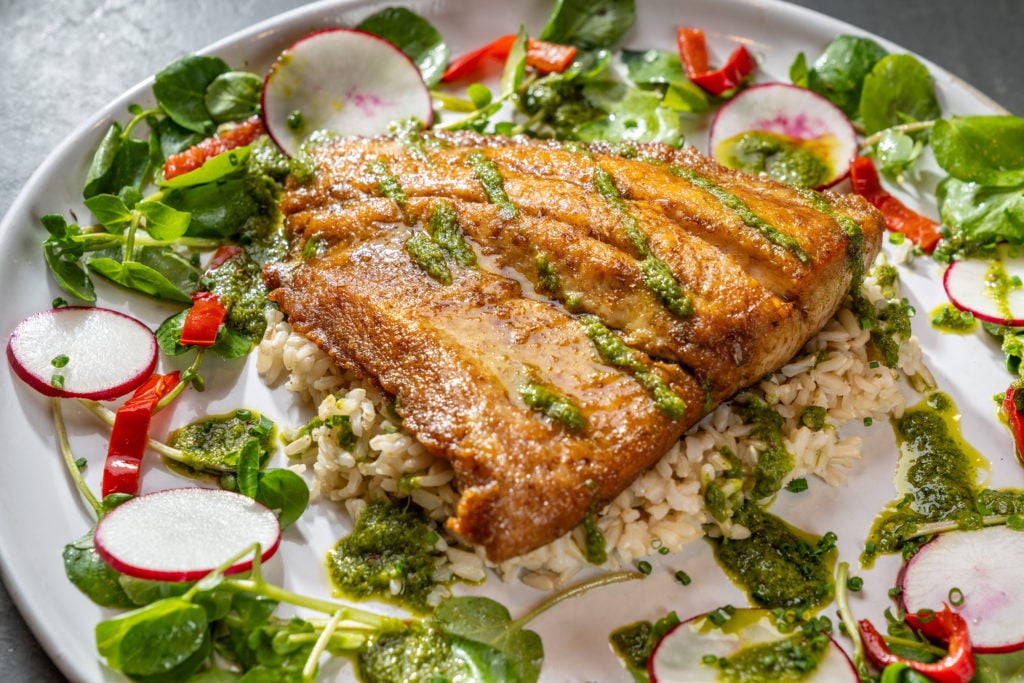Photograph by Greggory DiSalvo/Getty Images.
Of the DC region’s many fish, the one of poorest repute is the snakehead. An invasive species that arrived in 2002, the snakehead has been branded a scourge of the rivers, an existential threat to the ecosystem. It’s said to be crowding out other fish, like bass and perch, while spreading unchecked due to a creepy quirk of its biology: Snakeheads can breathe air and walk on land.
To fight the snakehead invasion, the state of Maryland would like us to eat them. But these fish are not often on menus or in grocery stores, which state senator Jack Bailey says is a result of their unappetizing name. That’s why he introduced a bill, which became law in April, to officially rename the snakehead the “Chesapeake channa.” (The law doesn’t affect the species’s scientific name, Channa argus.) Bailey’s goal is population control—or, as he put it on the phone in March, “If you can’t beat them, eat them.”
There’s precedent for rebranding a weirdly named fish to make it more appealing. The slimehead became the orange roughy. Dolphinfish became mahi-mahi. Famously, the Patagonian toothfish became Chilean sea bass, and suddenly diners couldn’t get enough.
But for snakeheads, the effort might be misguided. “They don’t need to rename the fish to make it palatable,” says John Odenkirk, a fisheries biologist with Virginia’s Department of Wildlife Resources. “People know what snakehead is, and they want it. The wholesale fish market can’t keep up with demand.” He’s right, says Stephanie Pazzaglia of the local seafood distributor J.J. McDonnell: “We do not have an issue at all—I repeat, at all—with selling snakehead.” Among the company’s clients is Leo, an upscale restaurant in Annapolis, which offers snakehead whenever possible (in part because it’s ecologically sustainable, but mostly because it’s delicious). Co-owner Hilarey Leonard says most guests don’t balk at the name—in fact, a lot of locals are excited to order it. Still, she’s considering using “Chesapeake channa” on this season’s menu, since the new name might make it “more mainstream.”

Maryland’s snakehead rebranding is an attempt to fuel demand—but actually, the issue seems to be supply. Sourcing these fish is a struggle, Pazzaglia says; snakeheads don’t swim through open water in large schools, so they can’t be netted en masse. Instead, they’re monogamous and territorial, with pairs nesting in shallow, marshy waters. That means they’re typically bowfished: An angler takes out a boat and shoots them with arrows, one fish at a time.
Thomas Miller, a professor of fisheries science at the University of Maryland Center for Environmental Science, says the name change can’t hurt: “But will it drive a surging commercial [market]? I don’t think so. And [would that] lead to the control and extinction of this species? Probably not.”
And honestly, that might not matter. Miller and Odenkirk agree that the snakehead isn’t causing the catastrophic ecological damage that many people once feared. “It is certainly an unwelcome new part of the ecosystem,” Miller says. “But I’m actually less concerned about snakehead than I am about blue catfish, which I think is a much more serious threat.”
While Miller wants snakeheads eradicated, Odenkirk seems quite fond of them. “It’s sort of an irony,” he explains, “that a lot of the fish that are here now aren’t native: redear, crappie, smallmouth and largemouth [bass]—all these fish people love.” Like those examples, snakeheads might someday be seen as a normal part of the ecosystem. But that would take years of reputational repair. In the meantime, you can eat all the Chesapeake channa you’d like—if you can find any, that is.
"fish" - Google News
April 30, 2024 at 09:58PM
https://ift.tt/98hgCsc
Maryland Renamed the Invasive Snakehead Fish. Will It Matter? - Washingtonian
"fish" - Google News
https://ift.tt/soaepJ7
https://ift.tt/7PrxU2M
Bagikan Berita Ini














0 Response to "Maryland Renamed the Invasive Snakehead Fish. Will It Matter? - Washingtonian"
Post a Comment